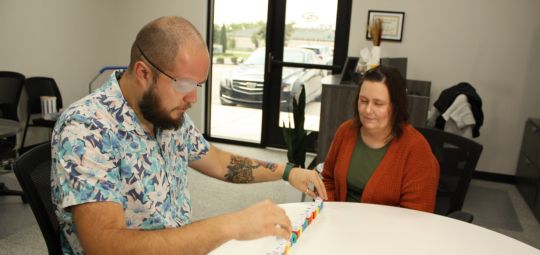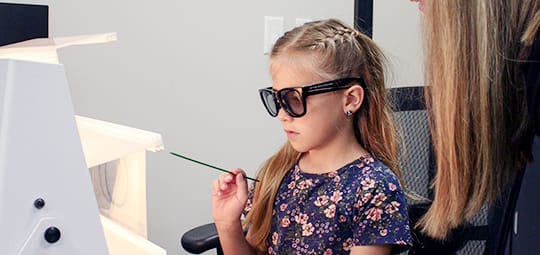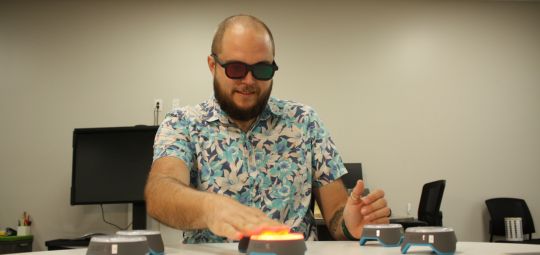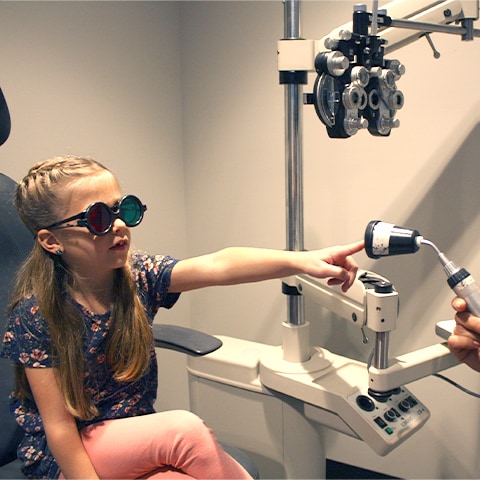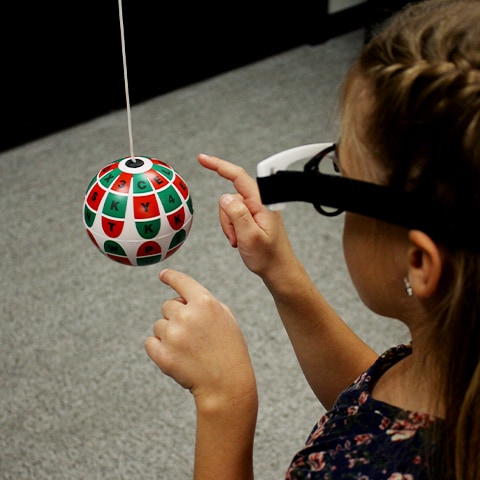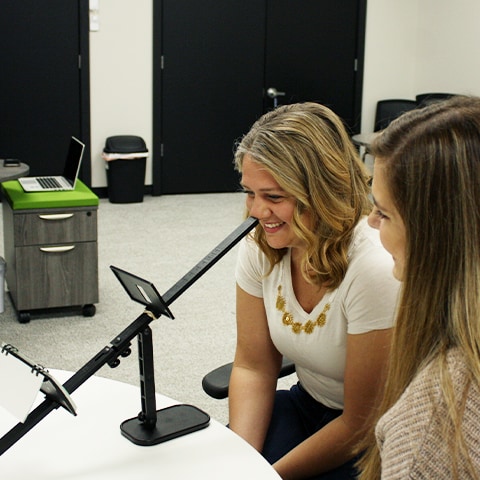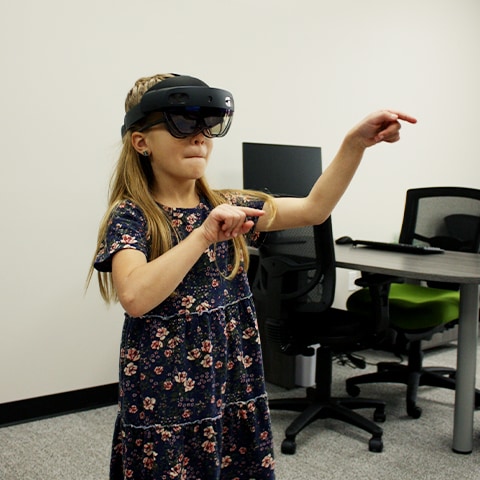What Is Vision Therapy?
Vision therapy is a personalized program to help improve or enhance visual function. How your vision functions affects more than clear eyesight. We engage visual skills every day to understand and connect with the world.
Vision therapy can be a game-changer for kids struggling in school, adults challenged by workplace productivity, and patients managing traumatic brain injuries. Eye Connect Vision Therapy aims to help patients improve their visual abilities and alleviate discomfort caused by vision conditions.
How Does Vision Therapy Work?
Vision therapy is customized to your needs. Like physical therapy or sports training, evidence-based exercises are the core of vision therapy. We use various tools, like specialty lenses, 3D glasses, and filters. At Eye Connect, we incorporate versatile technology in testing and treatment, like HoloLens augmented reality. Patients who’ve never seen depth can experience 3D objects for the first time.
Will Vision Therapy Help
When the brain and eyes work together seamlessly, optimal vision is achieved. Sadly, many children struggle with reading and learning due to undiagnosed vision problems, affecting 25% of individuals. Additionally, approximately 60% of problem learners encounter difficulties stemming from unrecognized vision issues.
Fortunately, there are alternatives to conventional solutions such as glasses, contacts, or surgery. Vision therapy, utilizing exercises, tools, and technology, can effectively retrain vision. Schedule a consultation to determine if vision therapy is right for you. Take our self assessment below to find out more.
Amblyopia Care
Amblyopia (lazy eye) is defined as reduced vision in one eye. Amblyopia is treatable at any age, but early detection and treatment can significantly improve outcomes.
Vision therapy for amblyopia focuses on reducing suppression and improving the abilities of the weaker eye. Exercises may focus on binocular vision activities (both eyes functioning together), spatial skills (hand-eye coordination), and depth perception (stereopsis).
Strabismus Care
Strabismus is the term for eye turn or misalignment, also known as crossed eyes. The aim of vision therapy for strabismus is to teach the brain and nervous system to control the eye muscles.
Exercises for strabismus may focus on binocular vision (both eyes working together), 3D stereo vision (stereopsis), and pursuits (smoothly following a moving target). Tools can include corrective lenses with or without specialty prism lenses.
Vision & Learning
Over 60% of the brain is involved with visual input and processing. Because vision is such a dominant sense, any condition affecting vision or visual processing can result in learning problems. In fact, 1 in 10 kids has a significant enough visual impairment to impact their learning success.
At Eye Connect, we get to know your kid and their vision needs. Then, we create a personalized plan to support their success, from school work to the visual skills they need to grow throughout their lives.
Brain Injury & Rehabilitation
Kids tend to avoid visual tasks that they feel are frustrating or exhausting, but many adults push through. Adults may find ways to compensate for uncomfortable or poorly performing vision. But brain injuries and neurological conditions can make compensating for daily visual tasks difficult.
Vision therapy uses a series of evidence-based sensory-motor-perceptual techniques to help improve visual function. Tools may include specialty lenses or graded filters.
Symptoms of Neurological-Related Vision Conditions
About 80–85% of our perception and cognition depend on visual information. Therefore, when the brain experiences trauma or neurological impairment, it can significantly impact visual skills.
Common vision problems associated with neurological conditions include:
- Blurred or double vision
- Fatigue or eye strain
- Reduced concentration ability
- A tilting sensation or dizziness
- Trouble shifting focus between distances
- Difficulty recalling visual information
Specialized Testing
Developing a customized treatment program starts with an in-depth visual system evaluation. We look at your eyes and the eye-brain connection. We use various tools and technologies to test visual skills and abilities, such as:
- Clinical Eye Tracker – Helps to test eye movements during our binocular vision assessment.
- Brock String – Offers instant feedback to the participant to judge how well the eyes are working together to focus on an object at various distances.
- Yoked Prism Glasses and Blazepods – When used in combination with our Blazepods, Yoked Prism Glasses give us the ability to test and improve looking behavior and to measure how long a patient is able to pay attention.
- Marsden Ball – During Marsden ball exercises, the ball in motion and the patient is asked to perform a variety of tasks, such as calling out the letters they see on the ball.
- Pegboard Rotator – A tracking instrument used to test and improve your ability to accurately direct your eyes from one point to another point with ease and efficiency.
- Aperture Rule – The patient is asked to look through a window in a slide at a series of targets placed at the end of the instrument. Each eye sees a different part of the target, with proper testing and assessment the patient learns to fuse the two images coming in from thier left and right eyes into a single picture.
Contact Us for a Consultation
Ready to find out how vision therapy can help you or your child? Get in touch with our team now.

I loved it here at the eye gallery. It was a blast. Gentry and Dr. Nola made it so much fun. they gave me so much encouragement through the whole thing. When something was hard they would help me and would give me the chance to get it right. When things were easy, they would say ok your results were good! You can move on! Or they would say ok, but let’s do this one more week so we know for you are good. Gentry was so kind and when I was kinda having a bad day, she would make me laugh and smile. I love Gentry and Dr. Nola so much! I will miss them so much! Thank you Gentry and Dr. Nola!!
Abby
Kyler was an average student that came home from school everyday complaining of headaches (this got worse during on-line Covid.) She disliked reading and her comprehension was on the lower side on assessments.
Within a month of vision therapy headaches were less frequent and homework was getting easier. Midway through headaches were gone and grades were improving. By the end she was reading for enjoyment and all grades were improved, even math!
Was it easy? NO! Did it take time out of my schedule to bring her? Yes! Were there tears shed? Yes! Was it hard work? Yes!
Would I do it again? YES!
Mikel
In the summer of 2022 when Dr. Baldwin told me that I needed vision therapy my initial thought was, “this is going to be pointless, I was just born with 80 year old grandma eyes.” My first appointment rolled around and I was able to meet with Dr. Nola about where my vision levels were and where they needed to be. After actually seeing the numbers I saw that I really did need help, and Dr. Nola was ready to teach me. After that I went home with charts, and patches, and glasses that made everything look weird. Little by little I notice that not only was my vision getting better, but my migraines that I had been having for almost a year finally went away! My reading scores/speeds on tests were also improving so much that even my ACT score went up 2 whole points in the span of 3 months! I know that none of this could have been possible without Dr. Nola, Gentry, Parker, Dr. Baldwin, and the rest of the staff at the Eye Gallery. I look forward to seeing them every week and I am so grateful to have them in my life not only as eye doctors, but also as friends that I felt comfortable with and excited to be around. Because of all of these reasons I can say that eye therapy has been one of the best decisions I have made.
Madelyn
Before Vision Therapy I was having a lot of headaches and it was difficult focusing on something far away and then quickly switching my gaze to something close. My therapist was Gentry and she was awesome. She always tried to make the exercises we were doing fun for me and always asked how my week was. Gentry also encouraged me to be consistent in my homework and it really paid off. Now after Vision Therapy I don’t have headaches or struggle doing school!
Claire
The change we have seen in Emily over the last six months has been priceless! She went from being unable to track enough to read and having zero depth perception to reading independently and doing great in her sports. Dr. Nola and Miss Gentry have been amazing in this process and we are so thankful for their care (and patience!). We have seen a change not only in her visual abilities but in her self confidence as well. Finishing this program is a big accomplishment for her and we are so proud!



